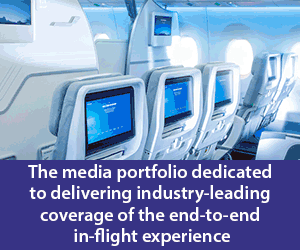TU Delft has presented cabin and seat designs for the Flying-V aircraft project, aiming to deliver lightweight benefits to the cabin for the energy-efficient aircraft as well as enhance the passenger experience.
The TU Delft Flying-V, a collaboration with KLM, is one of the avenues through which TU Delft is exploring ways to improve the sustainability of aviation. The aircraft design is expected to consume 20% less energy due to improved aerodynamics and lighter weight.
The designs for the new oval-shaped cabin were developed by Professor Peter Vink and industrial design engineer Thomas Rotte with 80 students of Industrial Design Engineering.
The concept includes four types of seating: beds, lounge areas, group seating and individual seats. Vink explained that: “The Flying-V can be arranged to suit customer needs, either in the traditional way, as in the current Airbus A350, or radically differently. The aim of our interior concept for the Flying-V is to improve the passenger experience at a lower weight and with passenger numbers comparable to the current Airbus A350.”
“We take advantage of the oval shape by creating beds and positioning the seats in the flight direction, to avoid passengers sitting shoulder to shoulder,” Vink continued.
Researchers found that 26% of passengers travel in groups, and so to reflect this the designers created an arrangement with two rows of two-seater chairs facing each other around a table, allowing those in a group to sit together and chat, eat or work together.
Current seating layouts mean people sit shoulder-to-shoulder in the cabin, but TU Delft has worked with Rebel to bring their staggered seat onboard, Vink said, “giving passengers the experience of more space… and no fight over the armrests!”
With research finding that 60% of passengers would like to sleep on long-haul flights, the Flying-V bed concept consists of three bed modules which can turn into a three seater sofa for an upright sitting position during takeoff and landing. A patent has been requested for the design.
Finally the chaise longue concept features rows of seats alternately mounted to the floor or ceiling creating space above and below the seats and enabling passengers to take different positions during the journey, such as sitting up to work or using the space to lounge.
The reactions have been positive, Vink tells Inflight but adds there is more research to be done including work with a 1:1 mock-up of the cabin features to test if passenger experience is truly improved. He adds: “A passenger booking a seat for five hours and bed for five hours on a ten hour flight seems nice in theory and looks nice, but it is hard to predict how people will behave – for example what happens once their bed booking has ended.”
“People like the idea, but it is good to try it in practice because it would be different in practice,” he continued. “There are many challenges but it is lovely to work on new challenges.”
The team are aiming to make the cabin as lightweight as possible, using innovative materials and Generative Design methods to find the best structure to support external forces (such as the weight of the passenger) and removing all material that is not needed – resulting in a lightweight and unique design.
Since the design for the Flying-V was presented, a team of engineers, technicians, students and researchers have built a flying scale model measuring 3.06 m in width and 2.76 m in length intended for scaled flight testing.
During the test flight the stability of the aircraft will be measured and tests will be conducted to determine the best angle for take-off and landing.





